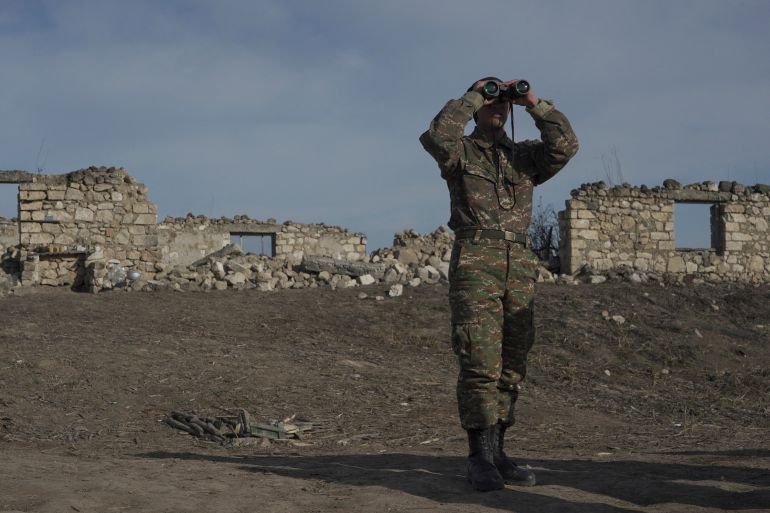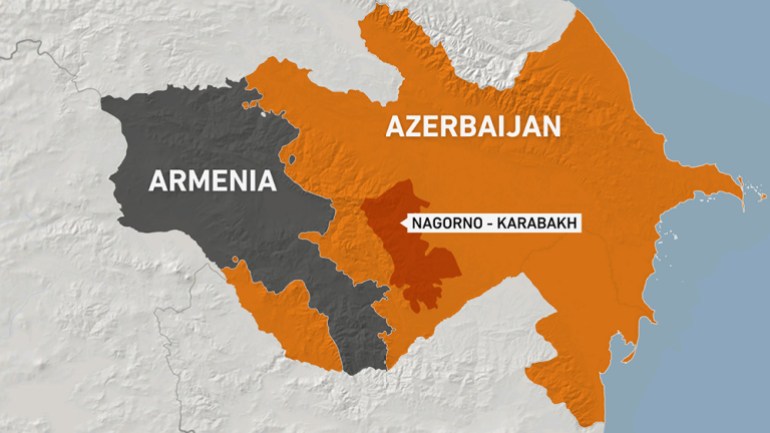What is Nagorno-Karabakh and why are tensions rising again?
Claimed by both Azerbaijan and Armenia after the fall of the Russian Empire in 1917, the region has remained a point of tension ever since.

Azerbaijan has launched “anti-terrorist activities” in the Nagorno-Karabakh region, saying it wanted to restore constitutional order and drive out what it said were Armenian troops, a move that could foreshadow a new war.
Armenia and Azerbaijan have already fought two wars over the region in the three decades since the Soviet Union they were both members of collapsed.
Keep reading
list of 3 itemsArmenia, Azerbaijan say troops killed in border shootout
Analysis: Will Azerbaijan-Iran tensions lead to war?
Here is a look at the history of the conflict and the latest developments:
What is Nagorno-Karabakh?
Nagorno-Karabakh, known as Artsakh by Armenians, is a landlocked mountainous area in the South Caucasus.
It was claimed by both Azerbaijan and Armenia after the fall of the Russian Empire in 1917 and has remained a point of tension ever since.
The territory is internationally recognised as part of oil-rich Azerbaijan, but its inhabitants are predominantly ethnic Armenians and have their own government, which has enjoyed close links to the government in neighbouring Armenia but has not been officially recognised by it or other United Nations member states.
Armenians, who are Christians, claim a long historical dominance in the area, dating back to several centuries before Christ.
Azerbaijan, whose inhabitants are mostly Muslim, links its historical identity to the territory, too. It accuses the Armenians of driving out Azeris who lived nearby in the 1990s. It wants to gain full control over the enclave, suggesting ethnic Armenians take Azeri passports or leave.

What is the history?
Over the centuries, the enclave has come under the sway of Persians, Turks, Russians, Ottomans and Soviets.
After the Russian Revolution of 1917, Armenia and Azerbaijan fought over the region. When the Bolsheviks took over Azerbaijan, Armenia agreed to Bolshevik control, ushering in the Sovietisation of the whole of the Caucasus.
Karabakh, with its borders redrawn to include as many Armenians as possible, remained as part of the Azeri Soviet Socialist Republic but with autonomy. Its name was the “Nagorno-Karabakh Autonomous Oblast”.
Under the Soviet Union, Nagorno-Karabakh became an autonomous region within the republic of Azerbaijan.
First Nagorno-Karabakh War
As the Soviet Union crumbled, what is known as the First Nagorno-Karabakh War (1988-1994) erupted between Armenians and their Azeri neighbours. About 30,000 people were killed and more than a million people displaced.
Azerbaijan lost a chunk of its territory, with Armenians left in control of most of Karabakh, alongside extra territory around Karabakh’s perimeter. Azerbaijan promised to take back control over the territory.
The 44-day war in 2020
In 2020, after decades of skirmishes, Azerbaijan began a military operation that became the Second Nagorno-Karabakh War, swiftly breaking through Armenian defences. Azerbaijan, backed by Turkey, won a resounding victory in the 44-day war, taking back parts of Karabakh.
The use of drones bought from Turkey and Israel was cited by military analysts as one of the main reasons for Azerbaijan’s victory. Several thousand people were killed.
Russia, a treaty ally of Armenia which also has good relations with Azerbaijan, stepped in to negotiate a ceasefire.
Under the deal, Azerbaijan was handed all of the territories surrounding Karabakh. That left ethnic Armenians in Karabakh with a much smaller territory. Armenia cast the war’s outcome as a disaster and unrest broke out in Yerevan.
The deal provided for Russian peacekeepers to deploy to Karabakh to guard the only road left linking the enclave with Armenia – the so-called Lachin Corridor – and construction of a new route along the corridor.
Azerbaijan pledged to guarantee the safety of traffic along the corridor in both directions.
Fighting continued to break out after the ceasefire, and in December 2022 Azeri civilians identifying themselves as environmental activists began a blockade of the Lachin Corridor, closing Karabakh to all but Russian peacekeepers and Red Cross convoys.
Azerbaijan denied it had fully blockaded the road, saying that some convoys and aid were allowed through.
What has happened in the past year?
In April, Azerbaijani troops set up a new checkpoint, near the Armenian border at the beginning of the Lachin Corridor, in what Armenia has said is an explicit violation of the November 2020 truce.
Azerbaijan said the move, which threatens to cut Karabakh off entirely, was aimed at ending Armenian arms supplies to what it calls a separatist administration.
The United States said it was deeply concerned by the move and called for free and open movement along the corridor.
The Kremlin said there was no alternative to the 2020 ceasefire agreement between Armenia and Azerbaijan and that it was working on talks between Baku and Yerevan.
The crisis on the Lachin Corridor strained ties between Russia and Armenia, which has repeatedly called for Moscow to enforce the November 2020 ceasefire and open the Lachin Corridor, while Moscow has said Armenia is refusing peace talks with Azerbaijan.
What is happening now?
This week, the International Committee of the Red Cross (ICRC) was able to make simultaneous aid deliveries via the Lachin Corridor and a separate road linking Karabakh to the Azerbaijani city of Aghdam.
Despite that, tensions have risen sharply this month, with Armenia and Azerbaijan accusing each other of building up troops.
Armenia has complained loudly that Russia’s war in Ukraine has distracted it from what Moscow itself says is its role as the guarantor of security in the South Caucasus.
Peace talks
Analysts say successive rounds of talks, mediated variously by the European Union, the United States and Russia, have brought the two sides closer to a permanent peace treaty than they have been for years, but a final settlement remains elusive.
The most sensitive issue is the status of the 120,000 ethnic Armenians in Karabakh, whose rights and security Armenia says must be guaranteed.
Prime Minister Nikol Pashinyan has said Armenia recognises the sovereignty and territorial integrity of Azerbaijan, but Baku says it is not certain the assertion was made in good faith and accuses Armenia of fuelling separatism.